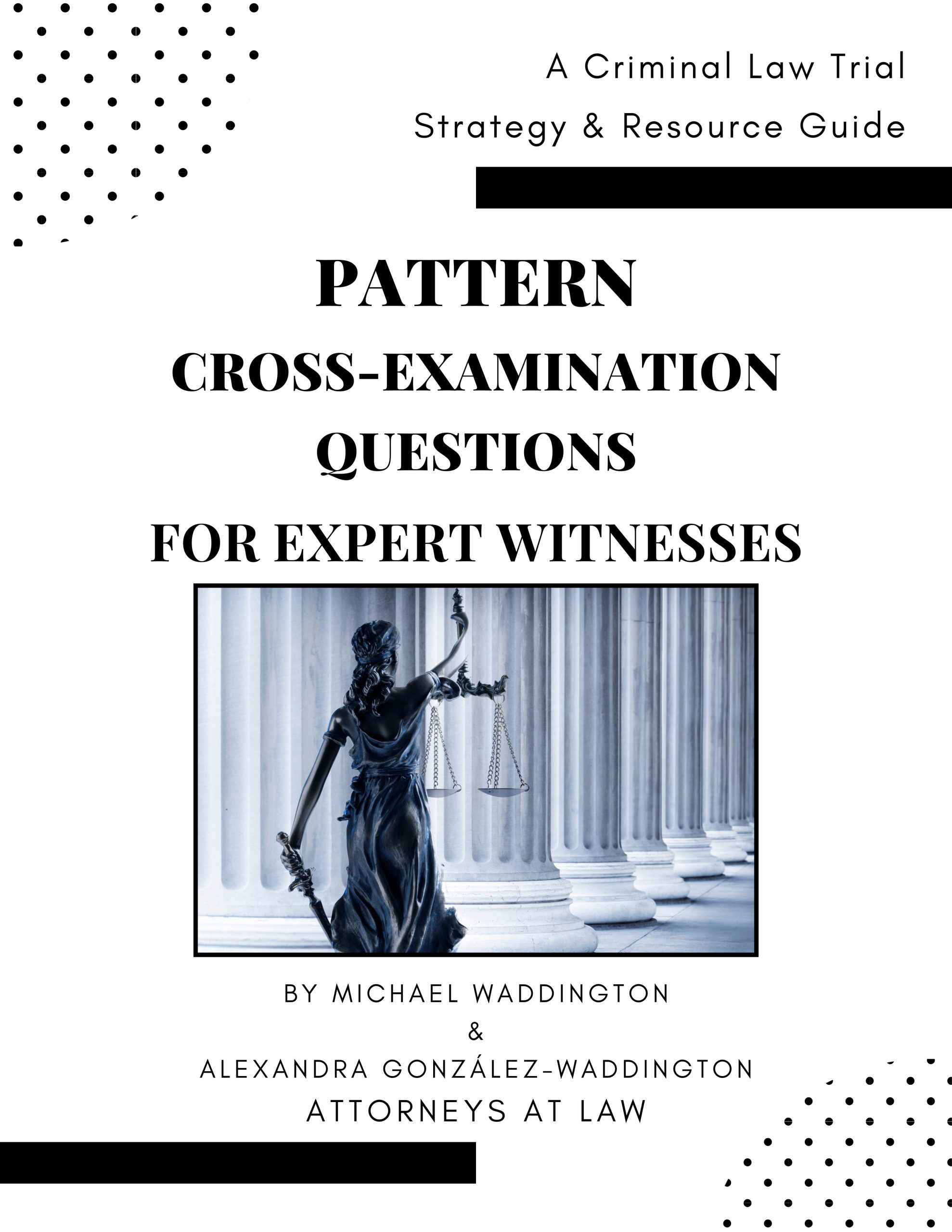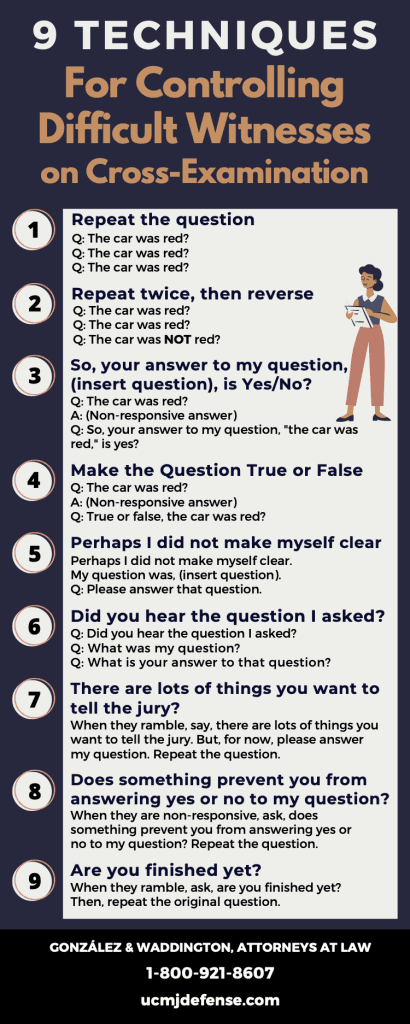Controlling Difficult Witnesses on Cross-Examination
FREE Cross-examination examples – Download our Cross-examination questions pdf
https://ucmjdefense.com/wp-content/uploads/2021/07/Pages-from-DNA-Pattern-Cross-FINAL.pdf
Cross-Examination Techniques Videos Cross-Examination Sample Questions:
- Cross-Examination Techniques: Part 1
- Cross-Examination Techniques: Part 2
- Cross-Examination Techniques: Part 3
Michael Waddington is a criminal defense lawyer, Cross-examination expert, best-selling author on cross-examination techniques, and a trial consultant who defends cases worldwide. Mr. Waddington specializes in defending serious criminal cases, including sex crimes, war crimes, military sex crimes, violent crimes, and white-collar crimes.
Pattern Cross-Examination of Expert Witnesses
 Cross-examining the prosecution’s forensic expert in a criminal trial may make the difference between victory and defeat. More and more aggressive prosecutors are relying on forensic psychiatrists, toxicologists, and other experts to help obtain convictions.
Cross-examining the prosecution’s forensic expert in a criminal trial may make the difference between victory and defeat. More and more aggressive prosecutors are relying on forensic psychiatrists, toxicologists, and other experts to help obtain convictions.
Some expert witnesses will do whatever it takes, including misapplying scientific research to bolster the prosecution’s case. For the sake of justice, defense lawyers must be able to cross-examine and nullify forensic experts effectively.
Both sides prominently used forensic experts in the second Bill Cosby trial and Harvey Weinstein’s New York trial. Counterintuitive victim behavior experts played a vital role in the prosecution’s trial strategy in these cases. This book will help defense lawyers neutralize such experts.
9 Techniques for Controlling Difficult Witnesses on Cross-Examination:
- Technique 1: Repeat the question.
- Technique 2: Repeat twice and then reverse.
- Technique 3: So, your answer to my question (insert question) is “Yes/No?”
- Technique 4: True or false.
- Technique 5: Perhaps I did not make myself clear.
- Technique 6: Did you hear the question I asked? What was it? What is your answer to that question?
- Technique 7: There are lots of things you want to tell the jury?
- Technique 8: Does something prevent you from answering yes or no?
- Technique 9: Are you finished yet?
Cross-examination techniques – controlling difficult witnesses on cross-examination Infographic
To maintain witness control, you must ask good questions and follow these rules:
- Prepare and have your impeachment resources available (prior statements, learned treatises, journal articles, etc.);
- Remain calm and unemotional;
- Do not answer questions posed to you by the expert (they are the ones testifying, not you);
- Ask only leading questions;
- Insert only one new fact per question;
- Break cross-examinations into logical progressions towards specific goals;
- Gain and maintain witness control;
- LISTEN to their answer. If they dodge the question, DO NOT MOVE ON or REPHRASE!;
- Do not back down until the witness answers the question you asked, and
- Potty train the witness.
Cross-Examination Expert: Subscribe to our YouTube Channel, The Trial Lawyers Notebook, for Cross-Examination Samples
He also teaches lawyers across the USA how to effectively cross-examine hostile witnesses and win trials. He has taught thousands of lawyers how to deliver closing arguments, powerful opening statements, and
Trial Strategy and Cross-examination Expert:
His bestselling book, The Art of Trial Warfare, I a legal strategy guide that is used by trial lawyers across the USA and taught at various law schools as part of their trial advocacy curriculum.
Cross-examination techniques
Best-selling author on Cross-Examination techniques, Closing Arguments, & Sexual Assault Defense
Michael & his law partner, Alexandra, wrote some of the best-selling books on cross-examination techniques, sexual assault defense, trial strategy, and closing arguments. All of our books contain closing argument samples and cross-examination questions examples.
- Pattern Cross-Examination for Sexual Assault Cases: A Trial Strategy & Resource Guide
- Pattern Cross-Examination Examples for DNA and Biological Evidence
- Pattern Cross-Examination Questions of Expert Witnesses.
Criminal defense lawyers across the United States use these books. All feature cross-examination techniques, cross-examination questions, and cross-examination examples for criminal and civil lawyers.
Expert on Closing Arguments: Subscribe for Closing Argument Samples
Mr. Waddington’s book, Kick-Ass Closings: A Guide to Giving the Best Closing of Your Life, is the #1 rated book on closing arguments. It has been an Amazon bestseller since it was published in 2018.
Call 1-800-921-8607 to speak with a false military sexual assault defense attorney today.
Gonzalez & Waddington, Attorneys at Law
We fight false military sexual assault claims worldwide.
We defend military sex crimes and military sexual assault cases worldwide and state criminal cases in Georgia, Pennsylvania, New Jersey, and South Carolina. We also handle federal criminal cases across the country.
Trial Lawyers Notebook – Cross-Examination Techniques
Below is a transcript from the YouTube video Cross-Examination Techniques – Part 2: Controlling Difficult Witnesses on Cross-Examination
This is Section 2 of a 3-part lesson where you will learn Techniques 1, 2, and 3 of the 9 Cross-Examination Techniques for Controlling Difficult or Hostile Witnesses.
These techniques work. They come from my 20 years of successful practice as a trial attorney. They work in criminal cases, civil cases, and any type of case. They work in front of a judge and a jury.
They work for me and will work for you in your practice, too.
These are very simple techniques. But, like most simple things, they are not easy to do. You need to practice.
Cross-Examination Technique # 1 – Repeat the Question.
Repeat the question.
It doesn’t get much simpler than that.
But this simple cross-examination technique can usually control 90% of witnesses.
Repeat the question.
- One new fact per question.
- Make sure it is a leading question.
- Make sure it can be answered yes or no if you can
Then – Repeat the Question.
To see how this works, we are going to review two fact patterns – one criminal and one civil.
Cross-Examination in a Criminal Case – Example 1
In the criminal case, somebody claims that they were attacked by a guy named Johnny, who tried to kill them. Johnny’s charged with either a sex crime or a violent crime.
We’re trying to show that this witness is exaggerating his or her fear of Johnny – and they have exaggerated.
Our point is that Johnny wasn’t so dangerous and wasn’t so dangerous at the time. They are exaggerating.
So the question goes like this:
Q: “You said that Johnny tried to kill you?”
A: “Yes, he did.”
Q: “After Johnny tried to kill you, you return to his house?”
And here comes the quibbling.
A: “Listen, I was under a lot of stress. You know, victims react differently,
and sometimes they do things that may seem odd.”
Okay, that’s not a responsive answer.
All we’re trying to ask is, “After Johnny tried to kill you, supposedly, you returned to his house?” That’s the point. It’s very simple.
But this witness doesn’t want to say yes.
So what do we do?
We repeat the question.
Q: “After Johnny tried to kill you, you return to his house?”
The answer is non-responsive.
A: “I know what you’re trying to do, make me look bad. But you don’t know what it’s like, you’ve never been through something like this.”
You can just imagine some of the responses you will get for these types of questions.
The point is, they’re non-responsive.
Don’t take the bait. Don’t say, “Well, I’m not trying to make you look bad. I do know what it’s like because I was attacked once.”
Don’t do it. Stick to rule number one, repeat the question.
Q: “After Johnny tried to kill you, you returned to his house?”
You may say the person’s name.
Q: “After Johnny tried to kill you, Mrs. Maria Smith, you returned to Johnny’s house?”
You can sometimes use their full name as a school teacher might do. But just repeat the question.
And if they are non-responsive and don’t say, “Yeah, I returned to his house.” or “Yes.” – then repeat the question until you get the answer, which is “yes.”
When Opposing Counsel Objects
Many times the opposing counsel will object and say something like, “Asked and answered.” We get that a lot.
You say, “No, Your Honor. My question was this, ‘Did she return to his house after he tried to kill her?’ That’s all we’re trying to get at? She has not given a responsive answer.”
Don’t get into an argument with opposing counsel about “she said this” and “No, she said this.”
Just very calmly say to the judge, “Your Honor, the question was, ‘After he tried to kill you, you returned to Johnny’s house? ‘She (or he) has not answered the question yes or no, about whether he or she returned the house. It’s as simple as that.”
And the judge will usually allow you to do that.
Don’t Ask the Judge For Help
You don’t want to ask the judge for help. I see that all the time. Attorneys will say to the judge, “Oh, Your Honor. He’s not answering the question, please.”
What that says to the jury is
- You don’t know what you’re doing
- You can’t control the witness
- The witness has the upper hand.
- You have to go to the judge, like the judge is mom or dad, and have them tell the witness to answer the question
If the witness does not answer the simple question you are asking, slow it down.
The jury understands what’s going on.
It’s About Who Looks Credible.
Here’s the key. It’s about credibility, like we discussed in Section 1.
If they the witness won’t even answer a simple yes or no question:
- They look evasive
- They look snarky
- They look quibbling.
Slow the tempo. Keep your demeanor. Don’t look exasperated.
Just repeat the question to get an answer.
Over time, the jury will tune out the witness as a person who doesn’t want to answer a simple question.
And the jury will think the witness is not credible.
So you win the battle.
You win with the answers you do get. And you win the battle when it comes to them being non-responsive.
Criminal Case – Example 2
Q: “After the rape, you returned to his house?”
A: ” What was I supposed to do? I left my phone there.”
That is not responsive to whether they returned to the house.
So you continue and say,
Q: “After the rape, you returned to the house?”
A: “I needed my phone for work.”
Does that answer the question?
No, it doesn’t.
So you repeat the question.
Q: “After the rape, you returned to his house?”
A: “Man, I don’t know what you’re getting at.”
Sometimes you will get all these explosive answers. So again, they’re losing credibility.
You repeat the question.
Q: “After the rape, you returned to his house?”
Now, let’s see this technique work in a civil case.
Cross-Examination in a Civil Case – Example 1
By now, you get the point.
Repeat, repeat, repeat.
That’s rule number one.
As we move through this section, the examples will get shorter. But with the first technique, I am giving you multiple examples, so you understand that you can apply this technique to any type of case.
For the civil case, let’s say you have an expert on the water in a water contamination case. Maybe someone was poisoned due to negligence, and there’s some water contamination, and you’re asking the expert about the water.
Q: “In this case, you conducted a test on the water?”
That’s your question.
A: “Why I conducted a lot of tests on a lot of things, Counsel.”
That’s often an answer you’ll get from an expert. Let them look like a jerk. I love to let experts hang themselves in front of the jury and look foolish, angry, and aggressive. They honestly look like jerks to the jury. Let them.
Repeat the question.
Q: “You conducted a test in the water?”
A: ” If by water, you mean the tap water. I looked at a lot of different areas and a lot of different things doing my job.”
Again, non-responsive.
Q: “In this case, you conducted a test on the water, Dr. Jones?”
Then, hopefully, you get a yes.
Cross-Examination in a Civil Case – Example 2
The same thing applies when you ask about testing for mercury.
Q: “Your test tested for mercury?”
A: ” I test for a lot of things, not just mercury.”
Q: “Your test tested for mercury?”
A: “I just told you we test for a lot of chemicals.”
Q: “Your test tested for mercury?”
Use silence
If it is your client, you want to teach not to talk when there is silence. But most people can’t help. They feel compelled to speak when there is silence.
And when there is silence, sometimes the witness will answer the question. Sometimes, they will just blurt things out.
The silence makes them feel uncomfortable. The accompanying video provides another example.
Cross-Examination Technique # 2 – Repeat, Repeat, Reverse
Cross-examination technique #2 is to repeat twice and then reverse the question
This technique is a riff and a spin on the first technique.
Repeat, Repeat, Reverse.
If the first cross-examination technique is effective on 90% of the witnesses, this will get another 5% of them.
This technique is usually a jolt for the witness, and they will answer the question.
So basically, you repeat the question and repeat the question, just like we did on the first technique.
But then, on the third time, you reverse the question. Make it a negative question.
This cross-examination technique is something you need to practice a bit. Once you get the hang of it, it gets really easy.
Cross-Examination in a Criminal Case – Example 1
We are using the same facts as above.
Q: “After Johnny tried to kill you, you returned to his house?”
You get a non-responsive answer, so you repeat the question.
Q: “After Johnny tried to kill you, you returned to his house?”
Again, you get a non-responsive answer, so you reverse the question.
Q: ” After Johnny tried to kill you, you never ever returned to his house?”
A: “Well, I mean, I did because I needed my phone.”
Q: ” Okay. So the answer to my question was, yes, you returned to his house?”
That’s one way to deal with the witness. You flip the question.
For example, if you ask them the question, “You said x? You said x?” and they say, “Blah, blah blah.” Non-responsive.
Then you can flip it and say, “So, you have never ever said x?”
You flip the question and put a negative spin on it.
When you do, they might react, “Well, hold on,” and then, for some reason, that triggers them to answer.
Cross-Examination in a Criminal Case – Example 2
Another example for the criminal case could be
Q: ” You returned to his house alone?”
The answer is non-responsive, so you repeat it.
Q: ” You returned to his house alone?”
Again, the witness is non-responsive, so here’s a way to flip the question.
Q: “When you returned to his house, you brought someone with you?”
It’s kind of a modification of “you returned to his house alone” question.
Here, we’re saying, “When you returned did you bring someone with you?”
And they say,” No, I didn’t.”
So, you continue and say, “Okay, so you returned to his house alone?”
You can have fun with this once you experiment with it and practice.
But stick to – Repeat, Repeat, Reverse.
Again, this works in civil cases and all cases.
I love to use this with a hostile witness in a civil case.
For example, asks the question. As they are fighting you – Just reverse the question.
Often, they will simply cave at that point.
Cross-Examination in a Civil Case – Example 1
As an example in a civil case,
Q: “In this case, you conducted a test on the water?”
Their answer is non-responsive, so you repeat.
Q: ” You conducted a test on the water?”
Again, they are non-responsive, but this time you say,
Q: “In this case, you DID NOT conduct ANY tests on ANY water?”
A: “Well, I mean, I did conduct tests on the water.”
This accomplishes two things. You get the answer you want. And, it shows the jury that this witness is playing games and they don’t want to answer the questions.
The jury sees that you are being forced to pull teeth and slowly extract the truth from the witness.
Cross-Examination in a Civil Case – Example 2
Here’s another example using the civil case.
Q: “Your test tested for mercury?”
The answer is non-responsive, so you repeat.
Q: “Your test tested for mercury?”
Again, the answer is non-responsive, so you reverse it.
.Q: “Your test DID NOT test for mercury?”
A: “Well, I mean, it did test for mercury.”
And then there are other comments you can say.
” Well, that was what I’ve asked you twice if your test tested for mercury. Why now are you saying that do test for mercury? Did you not understand my question the first time?”
Don’t use this and appear snarky unless the jury is right there with you.
If this goes on for an extended period and the judge and jury are with you, then you can make comments like this. But, I don’t recommend this language for amateurs.
If you know what you’re doing, you can read the jury, and you know what’s going on with the case – then sometimes say things like this to the witness to move them into the next question.
Again, we’re potty training the witness.
The jury sees that we really just want the answer. We are not trying to play games.
We want the answer.
Cross-Examination Technique # 3 –
So your answer to my question (insert question ) yes or no?
This is where it starts to get fun. If the witness is non-responsive, you can usually nail them and make them look kind of silly with this technique. And, its quick.
If the witness is not getting potty trained, you start escalating.
Now, all these techniques are escalating from 1 to 9. Number 1 is real simple – Repeat the question.
As we escalate up to Number 9, it starts to become a little more aggressive.
Don’t escalate straight to 7, 8, or 9 unless the jury is right there with you thinking, “What is going on? Why won’t the witness just answer the question?”
But you don’t want to go right to number 9. That is the Code Red nuclear option. You want to work your way up and use these sparingly.
Here’s how to use Technique 3 – So your answer to my question (insert question) is yes or no?
Q: “So after Johnny tried to kill you, you returned to his house?”
A: “What was I supposed to do? I left my phone there.”
Q: “So your answer to my question, ‘After he tried to kill you, you return to his house?’ is yes?”
And then they say yes.
Cross-Examination in a Criminal Case – Example 2
Or you can use
Q: “You returned to his house alone?”
A: “Well, I didn’t want to wake up my roommate.”
Q: “So your answer to my question, ‘you return to his house alone?’ is yes.”
And then you’ll get a yes answer.
I love this one. I use this all the time on law enforcement when they don’t want to answer questions. I also use it on experts when they’re really snarky or just hostile witnesses in general.
Yoke in the Expert
Here is one way to yoke the expert in front of the jury. Make it clear.
Q: “Hold on a second now. I’m not playing games. You’re in the big leagues. Don’t underestimate me based on my age, sex, gender, race.”
Many experts will look on you as the lawyer and assume things about you because they often think they are smarter than you.
Yoke them in and potty train him as a lawyer from the start.
Tell them, ” Hey, man, we’re not playing games here, Dr. Jones,” or whatever the doctor’s name is that’s up there trying to make you look stupid.
You maintain control.
You gain control.
You want to maintain control throughout and don’t let them out.
You want to get them in your vise grips and keep them there.
Cross-Examination in a Civil Case – Example 1
Here is an example of how to use Technique #3 in a civil case.
Q: “You tested for mercury?”
A: ” Again, I test for a lot of things.”
At this point, we’re not going to use Technique #1 Repeat, Repeat, Repeat.
And, we are not going to use Technique# 2 – Repeat, Repeat, Reverse.
We’re tired of this witness.
So calmly say,
Q: “Okay. Dr. Jones. So your answer to my question ‘you tested for mercury?’ is yes – That’s the answer to my question?”
And after a few times, they start getting it. They start understanding they are looking kind of silly. They’re looking kind of stupid to the jury and judge.
There’s another example where you just repeat the question and say, “So, your answer to my question is yes?”
But remember one new fact per question, and always leading question.
If you give a very long-winded question with many adverbs and adjectives, and multiple facts, you can’t do these techniques. You need to master the basics.




